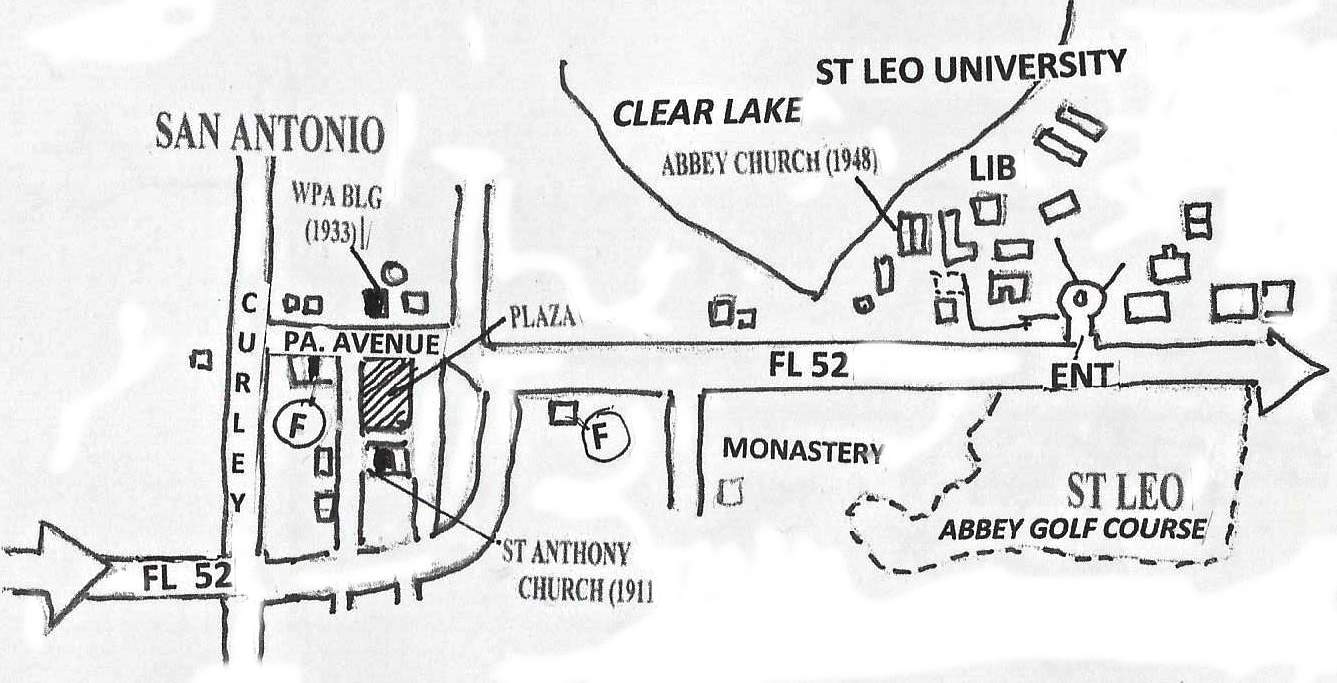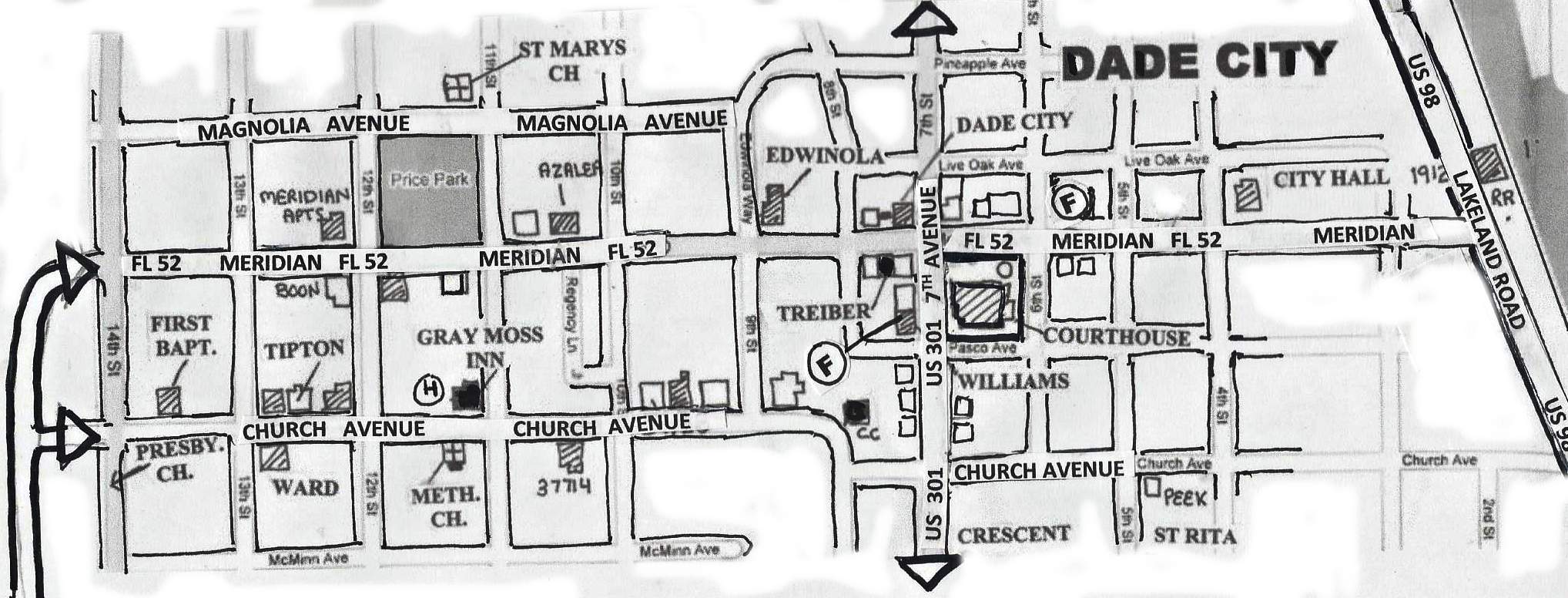
DADE CITY & EAST PASCO
COUNTY
POPULAR ANTIQUE
HUNTING SHOWPLACE
DADE CITY, capital of Pasco County,
is named for Major Francis Dade, who with 110 other soldiers was slain December
28, 1835, in a Seminole ambush. The founding of Fort
Dade at Lachoochee
protected homesteaders in the region but it wasn't until the arrival of the
railroad in 1884 that the present-day Dade City
boomed. Judge Samuel Pasco was U.S. Senator when the county was established in
1887.
SAN
ANTONIO,
five miles to the west, was started in February of 1882 by Edmund Dunne, former Chief
Justice of Arizona Territory and lawyer for land baron Hamilton Disston who gave Dunne 50,000 acres for his legal services.
Dunne set up a refuge for Irish and German Catholics and the small village has some of the oldest Catholic sites on the Florida West Coast. ST LEO developed around the college which started in 1890 as a monastery for the Benedictine monks.

WHERE TO START: EXIT I-75 ON FL 52 and travel east toward Dade City.
Five miles east, TURN LEFT (north) ON
CURLEY STREET (FL 577), then RIGHT ON PENNSLYVANIA AVENUE. When you see some of the old white frame Victorian houses on this street, you might wish to drive north of this intersection in search for the
1913 ST. CHARLES INN, a double-balconied two story that was built by Charles Barthle to serve the Orange Belt Railroad. It served as a bed and
breakfast for years but is gone as subdivisions now surround the San Antonio.
It is best to turn left on Pennsylvania Avenue and head toward the water tower next to the SAN
ANTONIO CITY HALL
(1933), 32819 Pennslyvania Avenue, a stone building which originally contained the city council,
police, and fire departments. The fire station of Engine Company 5 is next door. Across the street is some rustic commercial structures including the very colorful PANCHO VILLA MEXICAN RESTAURANT, whose parking areas for motorcycles only probably reflect the patrons. Also on the south side is the vast BICENTENNIAL PLAZA, a European style
park with a Memorial to Dunne, a nifty bandstand, and recreation facilities.
The town's RATTLESNAKE FESTIVAL is held here. It was for years the center of the Catholic
community when Dunne developed the colony.
TURN RIGHT ON MAIN STREET which is mainly lined with Victorian houses. , lined with old Victorian frame houses. My biased favorite is the JUDGE
JOHN FLANNAGAN HOUSE (1896), corner of Main and Rhode Island., residence for years of Dr Charles Arnade, editor of Latin American Review and my Latin
American history professor.. Flannagan was the area's biggest real estate promoter and
author of many travel booklets on the town. His house later held the Knights
of Columbus.
Also on Main Street is the DR. W. BRADSHAW HOUSE
(1896). AT South Curley is the 1912 CHARLES GAILMARD HOUSE, a
pioneer house with a three-sided wraparound porch.
Up Main Street is the THOMAS J.
QUIGLEY HOUSE (1880s), the oldest residence in the area. Quigley was a
pioneer in the Catholic colony and sold the hme to
the brother of town developer Judge Dunne, John Dunne, Vice President for
Hamilton Disston's Florida Land
and Development Company. In this capacity, John Dunne probably got the Judge
the 100,000 acres he purchased in Pasco
County.
Turn around if you were house hunting and GO EAST ON MASSACHUSETTS AVENUE. You
may wish to park to see the stone grotto and statue to St. Anthony next to the ST.
ANTONIO OF PADUA CATHOLIC CHURCH (1911), a twin-towered stone church replacing the 1883 original. Next door is the SAINT ANTONY SCHOOL (1922), begun
in April of 1884 when Mrs Cecilia Morse invited the
Benedictine Sisters to the village. The school is the oldest continuously operating school of any kind in Pasco County. The grotto and wall by the school was built
in 1935.
EXIT
THE SQUARE by turning left (north) on Hermann and then right AT COLLEGE ROAD and
travel east on FL52. You'll be a monastery up the hill on the left and pass a popular barbecue spot until you will TURN LEFT ONTO
THE CAMPUS OF ST. LEO COLLEGE, started in 1890 as a monastery by the
Benedictine monks. While St. Leo has a small school campus, the institution offers classes online and in person all over the USA and on military bases. I even saw a St. Leo program at a school in Madison, Florida, in rural North Florida.
The best visitor spot to park is by going left to PARK NEAR ST. LEO ABBEY BENEDICTINE CHURCH (1948), a Lombardic-Romanesque
structure with Indiana
limestone trim noted for its fine interior and marble Christ crucifix. You'll
recognize the image as a replica of a certain controversial cloth in Northern Italy.
The campus is beautiful with Lake Javita on the North side. Stroll over to ST. LEO HALL
(1915), a four-story concrete building designed by Brother Anthony Poiger. Next door is SAINT EDWARD (1926). The new boys dorm was
named for actor Lee Marvin, despite throwing a youth out a second-story window
while a student in 1941. Old timers might wonder if there is a way to find the rough trail across the highway FL 52 which once
contained the Garden
of Gethsemane (1935)
leading to the OUR LADY OF LOURDES GROTTO. Today the areas has the Holy Name BENEDICTINE MONASTERY. .
LEAVING ST LEO YOU NEED TO DRIVE EAST (left) ON FL52
along Meridian
Avenue into DADE CITY. The area west of downtown has many streets with Victoria masterpieces so a little block by block driving is in order for people who love well-preserved residences.
 TURN RIGHT (south) ON 15TH STREET and TURN LEFT
onto Church Avenue's
Historic District. At 37412 Church is the FIRST PRESBYTERIAN CHURCH (1894),
a wooden Gothic, the site of Central
Florida Normal
College. As you travel east along Church, you
can’t help to notice the fine Victorian houses and large yards. The RAYMOND-WARD
HOUSE at 37335 has a huge wrap-around porch. The BAPTIST CHURCH
was moved here from across town in 1910.
TURN RIGHT (south) ON 15TH STREET and TURN LEFT
onto Church Avenue's
Historic District. At 37412 Church is the FIRST PRESBYTERIAN CHURCH (1894),
a wooden Gothic, the site of Central
Florida Normal
College. As you travel east along Church, you
can’t help to notice the fine Victorian houses and large yards. The RAYMOND-WARD
HOUSE at 37335 has a huge wrap-around porch. The BAPTIST CHURCH
was moved here from across town in 1910.
Church
Avenue is
filled with notable houses: JAMES KNOX WARD HOUSE (1892), at 37805 Church, on the southside. is a classic Victorian
house, home of a blacksmith who became Mayor from 1903-1904. His wife took in boarders at the house.. The ROBERT ROSS-LARKIN HOUSE
(1882), 37603 Church, was once a three room cottage. Cattleman William Larkin,
who introduced the Santa Gertrudis strain to Florida once at 37604 is the JOHN W. PLATT HOUSE, used as the district Methodist parsonage from 1894 to 1905.lived
here. The Dutch Colonial style of
the KNIGHT HOUSE (1900),
at 37508 Church, is unusual for the area.
CROSS 13TH STREET. The entire block has older
homes but on your right at the end of the block is the 1888 JASPER CARTER
HOUSE..


600 Church Street
Presbyterian Church

 Downtown
Downtown
CROSS 12TH STREET. The last house on the left, opposite the Gothic FIRST
METHODIST CHURCH
(1889), built of heart pone and cypress by James E. Lee, is the GRAY MOSS
INN (1910), 37641 Church, a Mediterranean Revival Brummer House when President Calvin Coolidge lunched here in 1923..
TURN LEFT ON 11TH STREET. The last house on the left
is the PINHOLSTER HOUSE (1896), 37838 West
Meridian. CROSS
MERIDIAN AVENUE past Frank
Price Park. CROSS MAGNOLIA where on the left is the transplanted ST.
MARY'S EPISCOPAL CHURCH (1892), a tropical Gothic once located
in Pasadena.
TURN RIGHT ON ROBINSON where on the left at the end of the block is the
unique OLD BRICK JAIL (1892), the oldest brick building in town.
TURN RIGHT ON 10TH STREET
and travel two blocks where on your right at 103 Meridian Avenue is the ALALEA B&B/CHRISTOPHER LOCK HOUSE (1906), a two-story Dutch Colonial
with a gambrel roof.
Several other north-side sites to locate are:
the MOUNT ZION AME CHURCH (1918). 434 N. 7th Street, the oldest masonry
church in Pasco County
and a congregation started by freedmen in the 1870's on Lake Pasadena;
and the OLD STATE FARMERS MARKET (1935), 601 N. 10th Street,
a WPA Project built of native rock. Downtown Dade City is compact enough to park the car and visit the antique shops and restaurants - a popular trip for people in Tampa and Saint Petersburg.
TURN RIGHT ON MERIDIAN AND LEFT ON 9TH STREET to see the EDWINOLA INN (1912), once a
two-story concrete inn, now a large retirement center. RETURN TO MERIDIAN and TURN LEFT.
As you CROSS 8TH STREET,
on the left is the 1924 COLEMAN-FERGUSON DEPARTMENT STORE, Meridian Street. In
1884 Henry Coleman and William Ferguson started a store which promoted the tiny
town. Next door is the BANK OF DADE CITY (1917), a financial institution that did not survive the Florida Land Bust and became a store.
The stores on Meridian
downtown are the oldest in town; the TREIBER BUILDING
at 37846 was built in 1900 as a hardware shop. More interesting is the OLD CITY HALL,
now a store, past the courthouse toward the OLD RAILROAD DEPOT. It is a classic structure.
You have reached 7th Avenue (US301) and
should park to tour the downtown antique shops and visit the ) PASCO
COUNTY COURTHOUSE (1909), a two-story brick Beaux-Arts classic
by Artemus Roberts. The 1921 bandshell
is a landmark.
WHERE TO HAVE LUNCH: After a
visit around Historic Downtown Dade City, you will hopefully have reserved a
spot at (20) LUNCH ON LIMOGES
, 14139 South Seventh Street, (352-567-5685), a wonderful bistro located in the middle of the
1908 O. N. WILLIAMS DEPARTMENT STORE. People travel
for miles to eat here. In your downtown travels you will find other restaurants and even a tea house.Northeast of the Courthouse is KAFE KOKOPELLI (352-523-0056), a very funky and popular American restaurant in the 1916 Ford Motor store.
Other sites to locate on the southside of Dade City include: ST. RITA CATHOLIC
CHURCH BUILDING (1913), 1000 South 5th Street, now the Dade City Garden
Club; the GEORGE MASSEY HOUSE (1894), S. 5th Street, an old clapboard
with a bunch of added sleeping porches; and the CRESCENT TEATRE BUILDING
(1926), on Florida Avenue and South 5th Street, a Boom Time Mediterranean being
restored.
After downtown VISIT THE PIONEER
FLORIDA MUSEUM (567-0262), four miles north on US301. You'll love the
1864 Trilby Depot, the 1864 Overstreet House, the Lacoochee School,
and the Enterprise
Methodist Church.
There is a complete packing plant and a collection of some of the finest Victorian carriages and a unique oil carriage which supplied area farmers. ADMISSION is charged.
Seminole War buffs may want to see the
location of the SECOND FORT
DADE (1856),
located in the woods at the end of South
14th Street. Nothing remains of the fortress.






 Downtown
Downtown